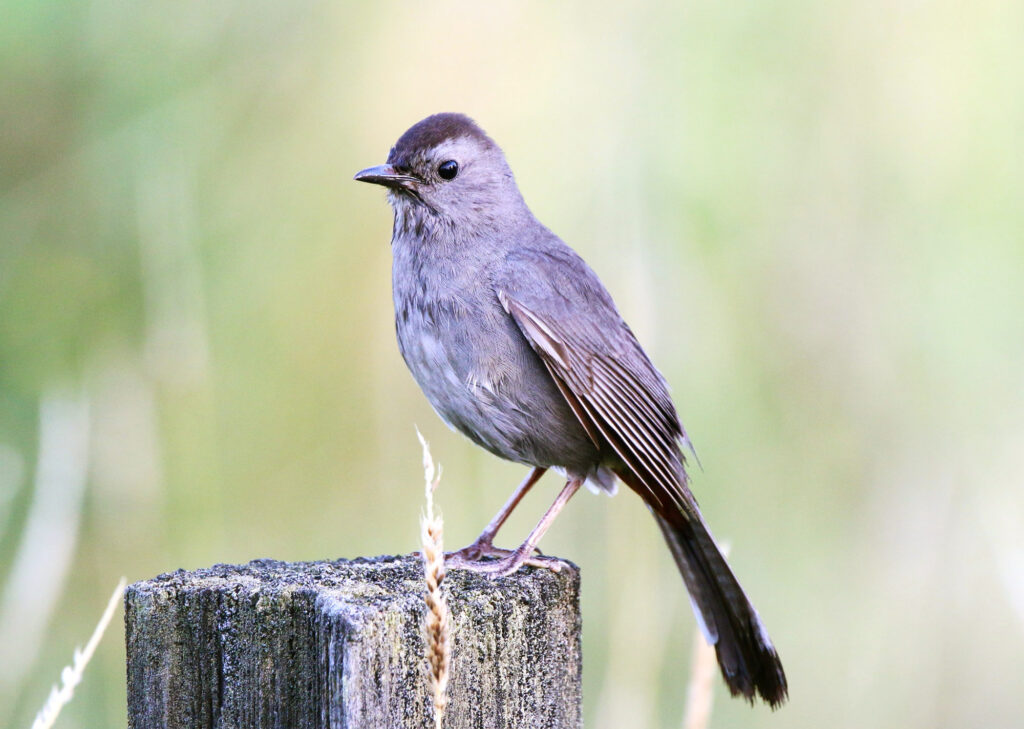GRAY CATBIRD, RANGE, SOUND, CALL, NEST, MEOW, PICTURES, MIGRATION, DIET
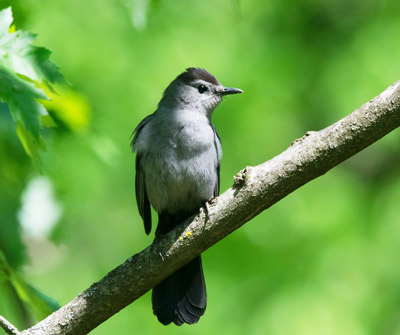
The Gray Catbird (Dumetella carolinensis) is a small, grey-coloured songbird that is native to North America. It is a member of the mimic thrush family, which is known for its ability to mimic the songs of other birds. This bird can be found in a variety of habitats, including woodlands, thickets, and suburban areas.
OTHER NAMES:
Slate-colored mockingbird, Common catbird, Northern catbird, Gray catbird and Grey catbird.
GRAY CATBIRD IN FRENCH:
Moqueur chat
COLORS
One of the most distinctive features of the Gray Catbird is its plumage. The bird’s upper parts are a soft, blue-grey color, while its underparts are a lighter grey. The male and female are similar in color, but the male has a black cap on his head.
This black cap is one of the ways to distinguish the male from the female. The bird’s tail is also unique, with long, thin feathers that resemble the tail of a cat. This is where the bird gets its name, also because of his meowing sound which can be confused for a kitten.
CATBIRD SOUND
The Catbird is a vocal bird and has a wide variety of calls and songs. Its call is a loud, sharp “meow,” which sounds like a cat’s meow. The bird’s song is a complex mixture of other bird songs, which it mimics.
They can mimic the songs of up to 20 different bird species, including the Baltimore Oriole, the Eastern Wood-Pewee, and the Eastern Bluebird. The bird’s ability to mimic other bird songs is one of the reasons why it is so popular among birdwatchers.
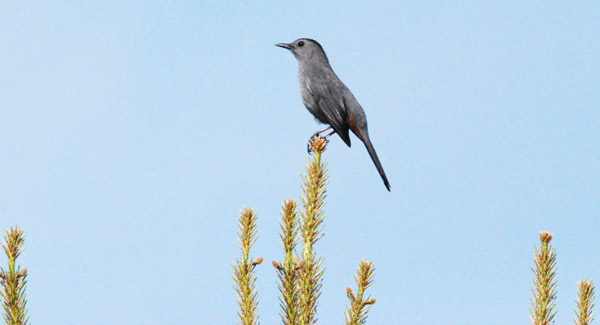
MIGRATION OF GRAY CATBIRD
The Cat bird is a migratory bird, and it breeds in the eastern part of North America. The bird migrates to the southern part of the United States and Mexico in the winter. The bird’s migration is timed to coincide with the availability of fruits and berries, which are an important food source for the bird. They tend to migrate during the nighttime.
CATBIRD DIET
The Gray Catbird is an omnivore and feeds on a variety of fruits, seeds, berries, insects (ants, beetles, caterpillars, flies, moths), and spiders. The berries they can be seen eating are holly berries, elderberries, cherries, poison ivy, blackberries, and bay.
FEEDER
This bird can be attracted to the backyard bird feeder with seeds including sunflowers hearts, suet, and nuts. Surprisingly, the oranges, which are known to attract Baltimore Orioles, could attract the Grey Catbird as well.
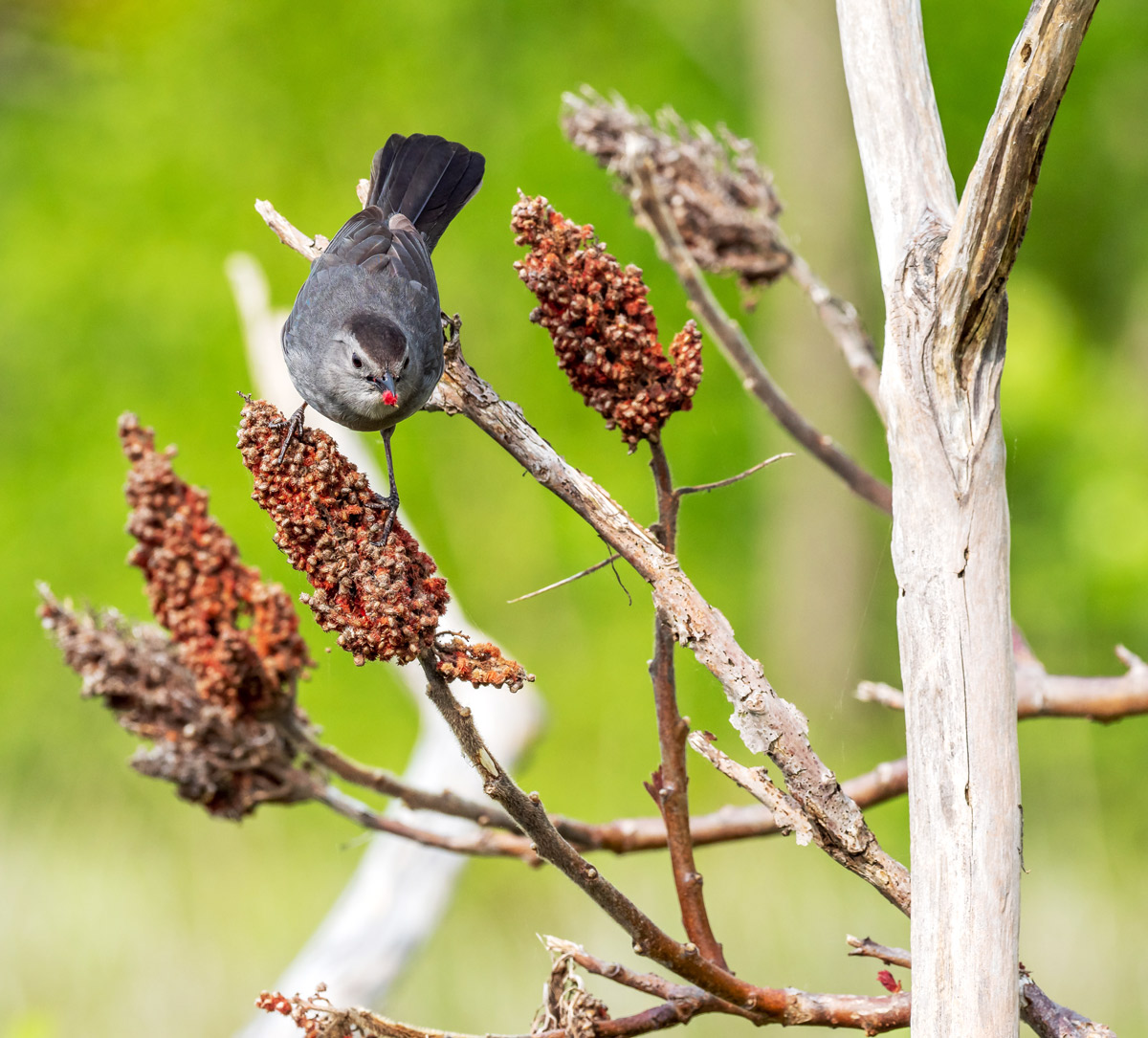
NOT ENDANGERED
The Gray Catbird is not considered to be a threatened or endangered species. However, like many other bird species, it is facing threats from habitat loss and fragmentation. The bird’s breeding habitat is being lost due to the conversion of forests and wetlands to agricultural and urban land.
Furthermore, the bird’s wintering habitat is also being destroyed by human activities. Therefore, it is important to protect the bird’s habitats to ensure their survival.
REPRODUCTION OF GRAY CATBIRD
Another interesting aspect of the Gray Catbird is its breeding behaviour. The male Gray Catbird is known to be territorial and will defend its territory against other males during the breeding season. The male bird will also perform elaborate courtship displays, such as fluffing up its feathers and fanning its tail, to attract a female mate.
NEST
Once a pair has formed, the female Gray Catbird will build a nest in a dense shrub or low tree. The nest is typically made of twigs, grass, and leaves and is lined with finer materials such as moss or hair.
The female bird will lay between two and four eggs, which she will incubate for about 12-14 days. Both the male and female will take turns feeding the chicks and protecting the nest. The chicks will fledge, or leave the nest, after about 10-12 days.
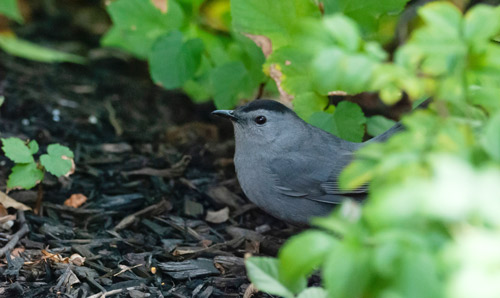
ADAPTATION OF CATBIRD
In suburban and urban areas, the Gray Catbird may have to adapt to human-altered environments. They are known to use gardens and parks as their nesting sites, and they have been observed to feed on fruits and insects found in these areas. They also have been observed to use bird feeders and nesting boxes provided by humans.
CONSERVATION
Conservation efforts have been made to protect the Gray Catbird and its habitat. Some of these efforts include the protection of wetlands and forests, the creation of bird-friendly gardens and parks, and the provision of nesting boxes and bird feeders for the birds.
KEYSTONE SPECIES
Another important aspect of the Gray Catbird is its role in the ecosystem. The Grey Catbird is a keystone species, which means that it plays an important role in maintaining the balance of the ecosystem. As a fruit eater, it plays a critical role in seed dispersal and plant reproduction.
The bird’s diet also includes insects, and it plays a role in controlling insect populations. It is known that the Gray Catbird’s nests provide shelter and nesting sites for other bird species and small mammals.
INDICATOR
The Grey Catbird is also an indicator species, which means that its presence or absence can indicate the health of the ecosystem.
The presence of a healthy population of Gray Catbirds is an indication that the ecosystem is healthy, while a decline in the population can indicate environmental problems such as habitat loss or pollution.
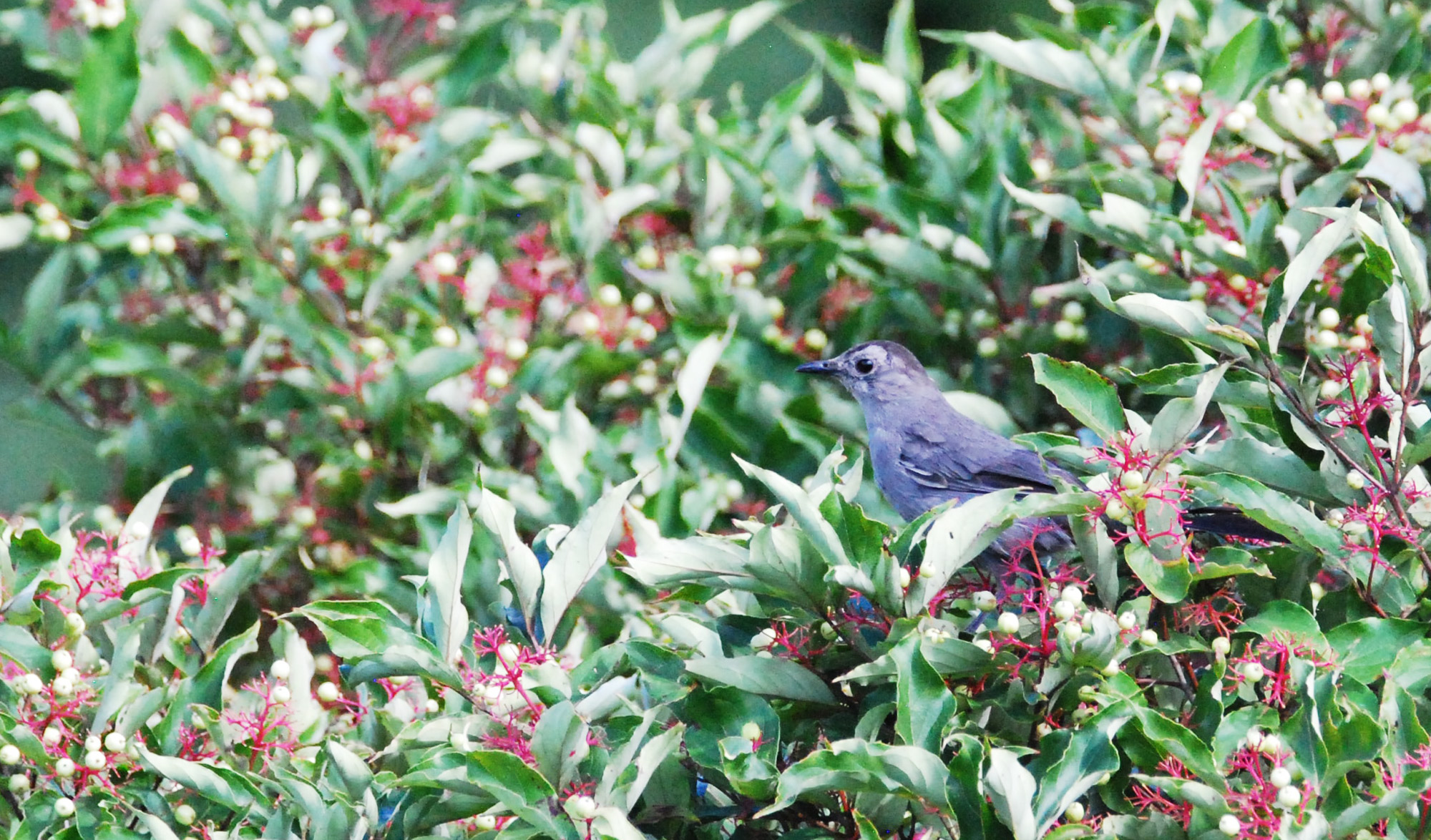
CATBIRDS ARE FACING THREATS
Despite their importance in the ecosystem, Gray Catbirds are facing several threats. Habitat loss and fragmentation, as well as pollution and pesticide use, are major threats to the species. Climate change is also affecting the bird’s migration patterns, food sources, and breeding.
Additionally, the bird is also facing threats from invasive species such as the European Starling and the House Sparrow, which compete for nesting sites.
PROTECTION OF THEIR HABITATS
To ensure the survival of the Gray Catbird, conservation efforts need to be made to protect the bird’s habitats and reduce the impact of the threats it faces. This can include protecting wetlands and forests, reducing pollution, and limiting the use of pesticides.
In addition, educating the public about the importance of the Grey Catbird and its role in the ecosystem can also help raise awareness and support for conservation efforts.
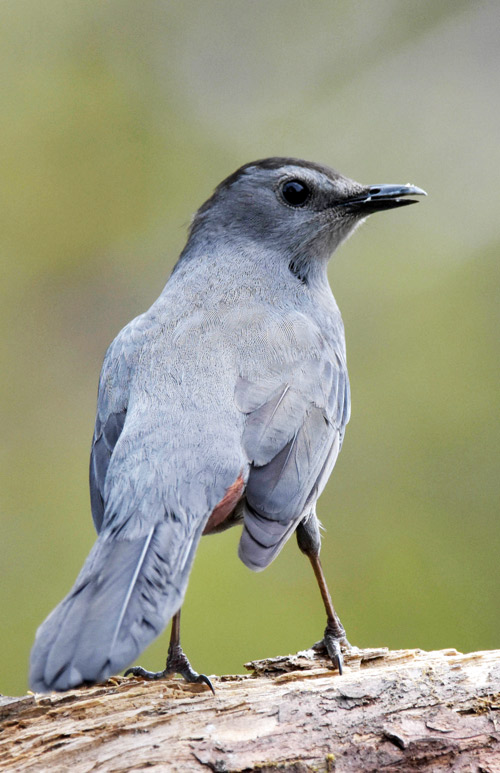
POPULATION STATUS
Another aspect of the Gray Catbird that is worth mentioning is its population status. The Gray Catbird population has been stable overall, but there have been some regional declines reported. In some areas, the Grey Catbird population has been impacted by habitat loss and degradation.
For instance, in the northeastern United States, urbanization, suburban sprawl, and changes in land use have caused a diminution in the bird population. Similarly, in the Great Lakes region, the conversion of wetlands and woodlands to agriculture has caused a decline in the bird population.
RESTORATION OF BREEDING HABITATS
Conservation efforts have been implemented to address these population declines. In the northeastern United States, conservation groups have been working to protect and restore the bird’s breeding habitats. This includes protecting and restoring wetlands, forests, and other habitats that are important for the bird’s survival.
Similarly, in the Great Lakes region, conservation groups have been working to protect and restore wetlands, woodlands, and other habitats that are important for the bird’s survival.
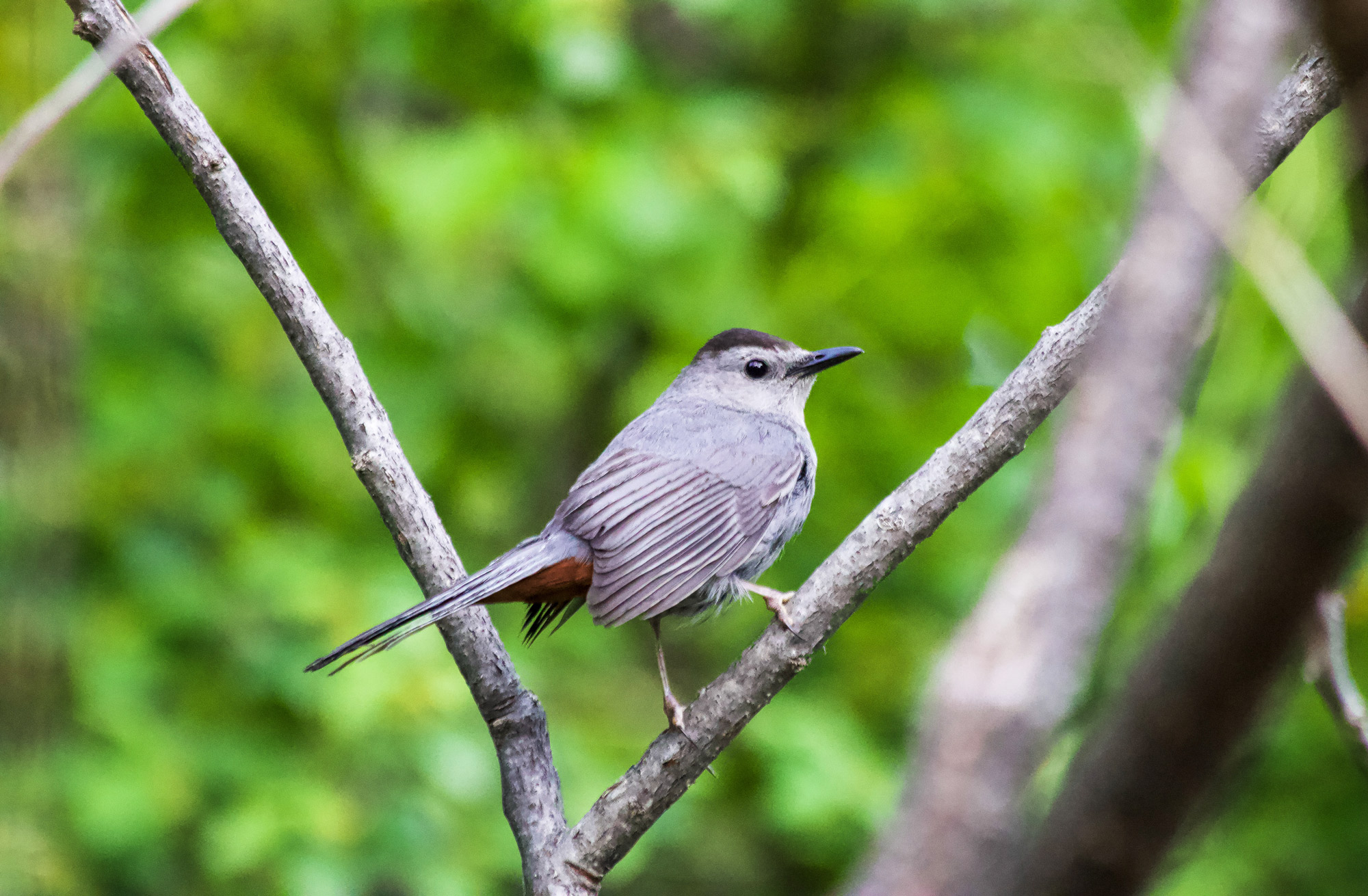
HABITAT MANAGEMENT
Another strategy that has been implemented to help protect the Grey Catbird population is habitat management. This includes managing forests, wetlands, and other habitats in a way that is beneficial for the bird.
In forests, for example, this can include maintaining a mix of different tree species, managing understory vegetation, and creating a variety of different-aged stands. Similarly, in wetlands, this can include maintaining a mix of different plant species, controlling invasive species, and creating a variety of different-aged wetlands.
EDUCATION ON GRAY CATBIRD
In addition to habitat management, another strategy that has been implemented to help protect the Gray Catbird population is conservation education.
This includes educating the public about the importance of the Grey Catbird, its role in the ecosystem, and the threats it faces. This can be done through various mediums such as brochures, websites, and nature walks.
SPECIES OF CONCERN IN SOME STATES
Another important aspect to consider when discussing the Grey Catbird is its conservation status. The Grey Catbird is not considered to be a globally threatened species, however, it is listed as a species of concern in some states and is considered a species of high conservation concern by the Partners in Flight organization.
This is due to its population decline in some regions, as well as the threats it faces from habitat loss, degradation and fragmentation, and other human-induced factors.
COMPETITION WITH OTHER BIRD SPECIES
However, the Gray Catbird’s adaptability also puts it in competition with other bird species for food and nesting sites.
For example, the European Starling and the House Sparrow, which are both invasive species, are known to compete with the Gray Catbird for nesting sites. In addition, the Catbird must compete with other fruit-eating birds for food.
In conclusion, the Gray Catbird is a versatile and adaptable bird that can coexist with many other bird species. However, it also faces competition from other species for food and nesting sites. In addition to its role in the ecosystem, the Grey Catbird is also an important species for birdwatchers and nature enthusiasts. Its ability to mimic other bird songs, its distinctive plumage and its cat-like tail make it a popular bird to observe and appreciate. This popularity can also be translated into support for conservation efforts to protect the bird and re-establish its population.
WANT TO LEARN MORE? TAKE A LOOK AT THESE ARTICLES:
- The Scarlet Macaw
- The Scarlet Ibis
- Lovebirds
- The Female Cardinal
- The Great Egret
- The Great Blue Heron
- The American Robin
- The Northern Cardinal
- The Dark-Eyed Junco
- The Blue Jay
- The Gray Catbird
- The Tufted Titmouse
- The Red-winged Blackbird
- The Black-capped Chickadee
- The Evening Grosbeak
- The Common Starling
- The Kiwi Bird
- Wild Birds Unlimited

